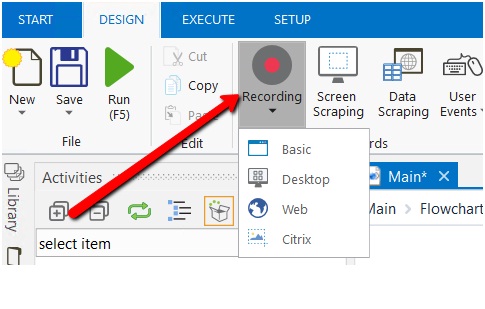The user interface of UiPath Studio has multiple panels for easier access to specific functionalities. It can be docked, function as floating windows, or the Auto-hide option can be enabled.
- The Ribbon – The ribbon is a simple window and can be minimized or expanded by clicking the Minimize / Expand It consists of the following four tabs:
- Start – to create new or open existing projects.
- Design – to create or launch sequences, flowcharts or state machine diagrams, access wizards, manage variables, and inspect user interface elements from third-party apps.
- Execute – Used to run or stop projects, for starting a debug process and open logs.
- Setup – To publish projects or create shortcuts. Scheduling tasks and installing extensions.
- The Quick Access Toolbar – Provides shortcuts for commands.
- The Universal Search Bar – To find activities, libraries, projects, etc..
- The Designer Panel in UiPath – It is the main dialog box shows the current project
- The Context menu in UiPath – Enables to perform operations in a sequence or flowchart. There are some fields like open, view, collapse, cut, copy, paste and so on.
- The Activities Panel in UiPath – Shows all the activities that can be used in the current project
- The Library Panel in UiPath – Enables to easily reuse automation.
- The Project Panel in UiPath – Used to view the contents of the current panel
- The Properties Panel in UiPath – To view and change the properties of any activity
- The Outline Panel in UiPath – Displays project hierarchy, all variables, and nodes
- The Output Panel in UiPath – Displays the output of Log message
- The Locals Panel in UiPath – Displays all variables which are locally in the current scope.
Automation activity package: Automation in UiPath is done in three different recording types. They are –


- Basic Automation – generally for activity, not container. Suitable for a single activity.
- Desktop Automation – used in native internal applications such as Word, Excel, notepad
- Web Automation – used in web browsers, for web scraping, etc.
- Citrix Automation – used to automate in a virtual environment.
The UI Automation has so many packages such as Click, double click, hover, activate, highlight, get OCR, load image and so on.
Automation life cycle’s process includes –

- Documenting the process
- Development and code review
- Test
- Release
- Monitoring

No comments:
Post a Comment